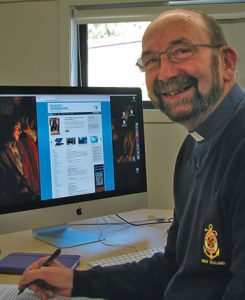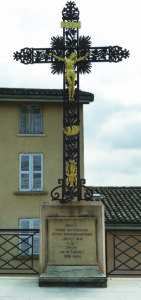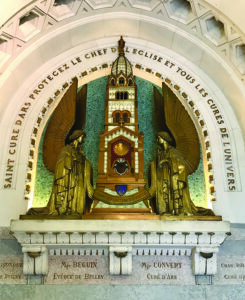St John Vianney and the First Marists
Part 2 of 2
Introduction
Much is known about the relationship between St John Vianney, the Curé of Ars, and Fr Jean-Claude Colin, the Founder of the Society of Mary. This is because Fr Gabriel-Claude Mayet wrote down so much about Fr Colin.
Much less is known about Jeanne-Marie Chavoin, the Foundress of the Marist Sisters, and the Curé. 1
The Curé sent many vocations to the various Marist branches as well as to other congregations. Fr Jean Coste lists the names of six who became Marist priests, ten who became Marist Sisters, and another six who became either Marist Brothers of the Schools or Coadjutor Brothers. 2 The lists are likely to be incomplete.
St John Vianney and the Third Order of Mary (Marist Laity)
Not only was St John Vianney a member of the Third Order of Mary, but he was also empowered to receive members into it, and recommended many of his penitents to become members. Fr Coste wrote, “Member of the Third Order of Mary, M Vianney can rightly be considered its purest glory and heavenly patron”. 3
Fr Colin speaking about the Curé of Ars
Fr Colin went to Ars many times and spoke about John Vianney on numerous occasions. He spoke approvingly of the Curé’s detachment from worldly goods and attitudes. At the same time, it is clear that Fr Colin thought that the Curé was not necessarily an example for everyone, or those living the Marist religious vocation. He was reserved in promoting him as a model to be imitated, “lest the Marists attach themselves to certain of the more eccentric traits” 4 that the Curé exhibited.
The Curé of Ars speaking about Fr Colin
From statements he made not only to Marists, but also to others, there is no doubt that St John Vianney considered Fr Colin to be a holy priest and even a saint.
For example, in 1850, when a group of Marists were visiting Ars and introduced themselves, the Curé responded, “What happiness is yours! In fact, you are the children of Rev Fr Colin, of that holy priest ... ”.
St John Vianney and Fr Jean-Claude Colin admired each other deeply. They did not hesitate in declaring each other saints, which was done more easily in those times than nowadays. 5
The Curé of Ars speaking about the Society of Mary
Speaking in 1832 to Gabriel-Claude Mayet when he was a sub-deacon trying to decide whether he should be a Marist or a Jesuit, the Curé of Ars said, “The Marists, they are a foundation according to the heart of God, for there is humility there, as well as simplicity ... They go about their work simply, beginning their missions with first communion catechism. Were I to choose between the Jesuits and the Marists, I should prefer the Marists, for the Jesuits are too well known, while, if you are a Marist, you are hidden. Another thing which is good is that the Superior of the Marists does not accept these brilliant candidates etc”. 6
Commenting on this statement, Fr Jean Coste says that “M Vianney had gone straight to the essentials and he knew thoroughly the congregation of which he spoke ...”. The “essentials” were insistence on catechism during the mission, a spirit of hiddenness, and Fr Colin’s approach to acceptance of new candidates for the congregation.
Another statement made by the Curé is significant because he made it to a diocesan priest to whom the Society of Mary was unknown. In a letter that Fr David wrote to Fr Mayet in 1863, he states that in about 1853, a novice from Belley overheard the Curé “talking to a priest from Grenoble about the Society of Mary. He had been impressed by this statement which came from the lips of M. Vianney: The Marists, they are the flower of the religious congregations”. 7
St John Vianney and the Marist Sisters 8
In 1853, two young women from Marlhes, Marguerite and Rose, made a pilgrimage to Ars, about 120 km away. Marguerite was engaged to be married and was going to ask the Curé for a blessing. After her sister was married, Rose intended to enter an Ursuline convent. Marguerite went first into the confessional.
As he blessed her, the Curé said, “Almighty God wants you to be a nun, my dear child”. “Excuse me, Father. It is not I, but my sister, who wishes to be a nun. I am about to be married”. “Your sister will marry your fiancé. You will not marry; it is not the Will of God. He wants you to be a nun, and a Marist nun”.
Marguerite was shocked, but since she was to be a nun, she decided that she would take her sister’s place with the Ursuline Sisters. The Curé gave them the address of a Marist Sisters’ house in Lyons. They decided that they would at least give the appearance of obeying the Curé by knocking on some random door in that city. They wandered around, keeping away from a large building that looked as though it might be a convent. They knocked at a modest-looking house, and a Marist Sister answered the door!
Marguerite recounted what had happened and her going to the novitiate was arranged. As Sr St Francis of Assisi, she became the superior of several houses and was elected Assistant General twice. 9
In conclusion
Fr Jean Coste wrote, “One of the noblest titles of the early Marists is certainly that of having drawn to themselves the love and esteem of a priest who lived so close to God, while the memory of the solicitude of the Curé d’Ars for our Society should be an incentive for us today to show again in our lives those characteristics which had won over his heart to our religious family”.
1 See MM, August 2020 pp 16ff
2 Fr Jean Coste, Acta SM 27 T. V Dec 1959, pp 405-407
3 ibid., p 415
4 ibid., p 383
5 ibid., p 387
6 ibid., p 391
7 ibid., p 393
8 See also MM, August 2020, pp 16 ff
9 MM 1 August 1933, pp 34 ff



 Entries(RSS)
Entries(RSS)